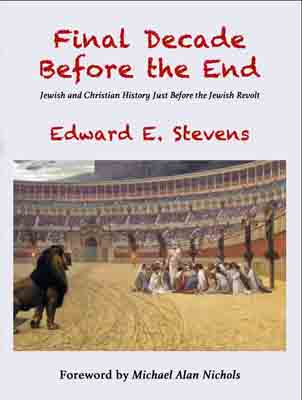One Column Page
and responsive to boot
Parousia, Resurrection, Change, and Rapture, cont.
by Edward E. Stevens
This article appeared in the 2021 Winter issue of Fulfilled! Magazine

In our two previous articles we sequenced and documented the historical fulfillment of the Great Tribulation, the Abomination of Desolation, the Zealot rebellion, and the Man of Lawlessness. This article shows not only where the Parousia and the Resurrection fit into the overall sequence of endtime events, but also how they actually occurred in May of AD 66.
‘Cutting Short’ the Great Tribulation
The outbreak of the Zealot rebellion on May 12, 66 forced both Jews and Romans to turn their attention away from killing Christians in order to fight the war against each other. This was the relief from tribulation that Jesus and the apostles had promised the first-century saints (Matt 24:22; 2 Thess 1:7; 1 Thess 1:10; cf. 2 Peter 2:9). But there was no relief for the unbelieving Jews—their tribulation had only just begun, and it intensified rapidly into the wrath outpouring (2 Thess 1:6-10).
Thus, it was “for the sake of the elect” (not the unbelieving Jews) that the tribulation was “cut short” (Matt 24:22), thereby allowing some of the saints to remain alive until the Parousia in order to be gathered into Christ’s presence by the angels before God’s wrath was poured out on their persecutors (Matt 24:31; 1 Thess 4:17; 5:9; 2 Thess 2:1).
The Parousia
The rebellion’s beginning set the stage for the Parousia. Since Christ foretold He would come “immediately after” the tribulation was cut short (Matt 24:22, 29-30), and since the tribulation was cut short by the outbreak of the rebellion, Christ must have come “immediately after” the rebellion began. And that is exactly what we find in the historical accounts. The rebellion began on May 12, 66, and four days later the Parousia began (May 16, 66). Here is how Josephus, Yosippon, and Hegesippus reported it:
Not many days after that feast [Passover week, Apr 10-17, 66], on the twenty-first day of the month Artemisius [May 16, 66], a certain prodigious and incredible phenomenon appeared . . . related by those that saw it . . . for, before sunsetting, chariots and troops of soldiers in their armor were seen running about among the clouds, and surrounding of cities. [Josephus, Wars 6.296-299 (6.5.3)]
. . . a certain figure appeared of tremendous size, which many saw . . . and before the setting of the sun there were suddenly seen in the clouds chariots and armed battle arrays, by which the cities of all Judaea and its territories were invaded. [Pseudo-Hegesippus, translated by Wade Blocker, made available by Roger Pearse; Chap. 44.]
Now it happened after [Passover] that there was seen from above over the Holy of Holies for the whole night the outline of a man’s face . . . Moreover, in those days were seen chariots of fire and horsemen, a great force flying across the sky near to the ground coming against Jerusalem and all the land of Judah, all of them horses of fire and riders of fire. [Sepher Yosippon: A Mediaeval History of Ancient Israel. Translated by Steven B. Bowman; Chap. 87 “Burning of the Temple.”]
Jesus told His disciples that everyone in Judea, including the unbelieving Jews, would see the coming of the Son of Man with His angels (Matt 24:30; Luke 21:27). It would be as obvious and unmistakable as lightning flashing across the nighttime sky (Matt 24:26-27; Luke 17:24). Even the unbelieving Jews were allowed to see it, so that they would have no excuse afterward for rejecting Christ. They saw exactly what Jesus said they would see (Matt 26:63-64; Mark 14:61-62; Luke 22:66-71).
This appearance of Christ and His angelic armies in the sky above Judea occurred only four days after Eleazar b. Ananias began the rebellion and took control of the temple. That was definitely “immediately after” the tribulation on the saints was cut short (Matt 24:22, 29).
Thus, Josephus gives us the exact day and hour when the Parousia began. It occurred just before sunset on Artemisius 21st (May 16, 66). And it was not just a one-day event, but rather an extended period of time (AD 66-73), during which Christ rescued His saints and destroyed His enemies (Matt 24:29-31; 2 Thess 1:6-10).
Resurrection, Bodily Change, and Rapture
Since the outbreak of the rebellion cut short the great tribulation (persecution) of the elect, it enabled some of those saints to remain alive until the Parousia, at which time the dead saints were raised out of Hades, the living saints were changed, and then both groups were “caught up together” to be with Christ in the unseen realm above.
That is how Apostle Paul sequences these three events. He states that “in a moment, in the twinkling of an eye, at the last trumpet” the dead would be raised imperishable, and the living saints would have their mortal bodies changed into immortal bodies (1 Cor 15:51-52). Thus, the living were changed at the same instant the dead were raised out of Hades. Then both groups of saints, now in the unseen realm, were caught up together as one group to meet Christ and remain with Him forever (1 Thess 4:16-17).
In a previous article (Winter 2020), we noted that all three of these events (resurrection, change, and rapture) occurred on the day of Pentecost (May 30, 66), two weeks after the angelic armies were seen in the sky at the beginning of the Parousia (May 16, 66).
These Events Occurred on Two Different Sundays
Since Pentecost occurs on the first day of the week every year (Lev 23:15-16), and since the angelic armies appeared exactly two weeks before Pentecost, then their appearance must also have occurred on the first day of the week (Sunday).
Where would those saints who remained alive after the tribulation was “cut short” have been on the first day of the week? Paul reminded them that they should not forsake their assembling together, especially when they saw the signs that the eschatological Day was drawing near (Heb 10:25). And this exhortation to meet together every Sunday applied to them even during the Neronic persecution (AD 64-66), when such assemblies were dangerous and difficult, and had to be arranged secretly and securely.
Thus, it seems certain that those persecuted saints would have been huddled together behind closed doors on those two Sundays when the angelic armies appeared in the sky, and when the resurrection, change, and rapture occurred.
Imagine the electrified discussions at their Sunday assembly right after seeing the angelic armies in the sky! They most likely focused a lot of attention on what Jesus said in Luke’s account of the Olivet Discourse:
“Then they will see the Son of Man coming in a cloud with power and great glory. But when these things begin to take place, straighten up and lift up your heads, because your redemption is drawing near.” [Luke 21:27-28 NAS95, cf. Matt 24:29-31]
Notice the sequencing here. First, they would see Christ coming with His angels in power and great glory. Then, soon afterward, they would be redeemed (the bodily change and rapture).
That must have been an extreme encouragement to any of those saints who were at the point of despair in the persecution. They had just seen Christ arrive with His angels. They now knew for certain that their redemption was drawing very near (any minute now)!
When Jesus told them to straighten up and lift up their heads, it implies that their tribulation (the Neronic persecution) had been cut short, and their redemption was drawing near. This means that their “redemption” (the bodily change and rapture) did not occur at the beginning of His Parousia when they saw the angelic armies appear in the sky. Instead, it was still yet to come, but drawing very near. How near was it?
Two weeks after the angelic armies were seen in the sky, the priests in the temple heard the loud voice of a great multitude in the unseen realm saying that they were leaving one place in the unseen realm and going to another, “Let us go from here!” [Josephus, Wars 6.300 (6.5.3)]. This was the resurrection of the dead out of Hades. It occurred on the day of Pentecost (May 30, 66), which was the first day of the week (Sunday), at the very time when Christians were assembled for worship behind closed doors.
This helps explain why no one saw the living saints changed and taken. During the Neronic persecution, no one but Christians would have been assembling with them. The unbelievers would not have dared to meet with them, for fear of being arrested and put to death. Nor would it have been safe for the saints to allow any unbelievers in their assemblies. Thus, it would have been a perfect time for those saints to be changed and taken during their secret assemblies on the first day of the week. Apparently, that is exactly what happened.
For more details, request these articles by email:
• Why No One Noticed the Rapture
• Outbreak of the Rebellion – The Real History
• Let Us Go From Here
Comments:
Your honest review will help others in their search for truth. If you must leave a negative review please be gracious.
Rather, speaking the truth in love, we are to grow up in every
way into him who the head, into Christ . . . .
(Ephesians 4:15)
 Fulfilled
Fulfilled